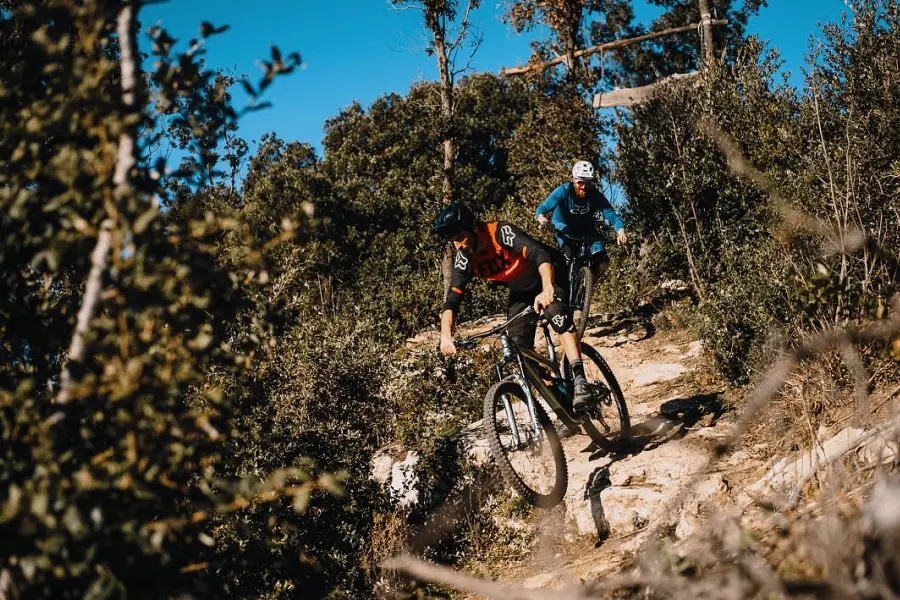If you want to purchase a mountain bike, you might wonder if you should buy a cross country vs trail bike.
These bikes have some similarities, such as that they can both handle a good variety of terrain, but they have important differences that you should know about before you go ahead and choose one.
What’s the main difference between these two bikes? A cross-country bike is light in weight and excels in long-distance cycling, while a trail bike is more versatile.
But that’s just the tip of the iceberg! Read our guide to learn more about cross-country bikes vs trail bikes so you can make the best mountain bike choice for you and your racing style.
Contents
What Is A Cross-Country Bike?
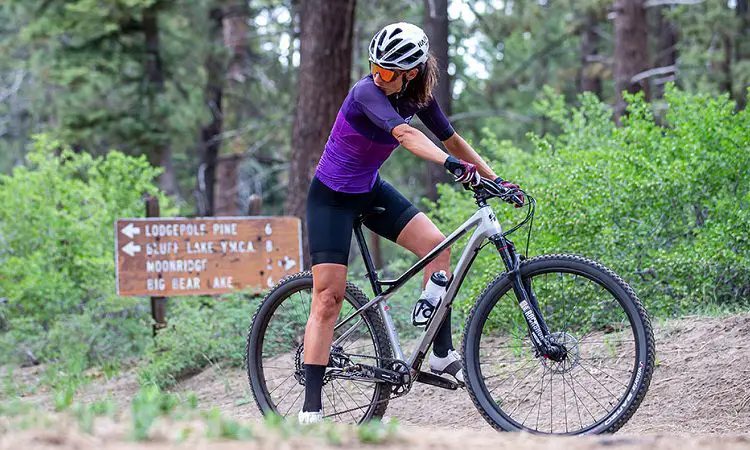
This type of mountain bike, which is sometimes referred to as an XC bike, is focused on speed. This is beneficial when you need to race up hills or around tracks. It has a similar appearance to a classic mountain bike.
Since they’re all about achieving high speeds, these types of bikes are usually constructed out of carbon fiber so that they remain as lightweight as possible. However, note that a cross-country bike doesn’t have much going for it in terms of comfort.
The modern cross-country bikes you’ll find have some of the biggest wheel size, coming in at 29 inches. They’re built to be lightsome and weigh less than 24 pounds! You can also find hardtail versions, which are bikes containing only front suspension.
Pros
- A cross-country mountain bike is meant to cover a variety of off-road terrains in a quick way.
- It’s a versatile type of mountain bike – it’s ideal for smooth roads, single-track riding, forest paths, and trails with lots of twists and turns.
- It’s the lightest type of mountain bike on the market.
- If carbon fiber bikes are out of your price range, you can find aluminum bikes.
- With features such as longer chainstays and steep head angles, these bikes put cyclists into much better climbing positions.
Cons
- You do require skills to ride it as a cross-country bike has less suspension travel than trail bikes. This is something to bear in mind if you’re trying to navigate steep and rough trails.
What Is A Trail Bike?
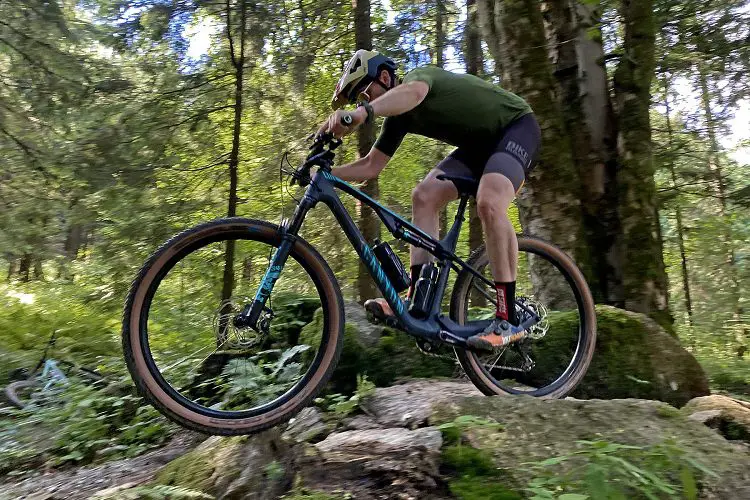
By comparison, a trail bike is a type of mountain bike that’s ideal for cycling on rougher roads and uneven terrain. If you need the extra boost of adrenaline, a trail bike is a good choice!
A trail bike can be described as the type of bike that comes to mind when people think of a mountain bike. It’s a versatile bike that performs well with climbing and descending hills.
Since it has more suspension on board and less stiff geometry than a cross-country bike, it can handle a variety of terrain.
Pros
- You’ll be able to ride over rough rocks and perform jumps when using a trail bike.
- At the same time, a trail bike can be ideal for backcountry rides.
- What’s great about a trail bike is that it has a neutral head angle so that it can accommodate a variety of riding styles.
- This bike’s tires are a good blend of durability, rolling efficiency, as well as traction.
Cons
- It’s not a mountain bike that should be your ideal choice if you want to be able to perform really well at high speeds.
Cross Country vs Trail Bike: What Are The Differences?
Now that we’ve looked at some pros and cons of both types of mountain bikes, let’s explore their differences in greater detail according to different categories and features.
Front Suspension

A cross-country bike usually contains stiff forks that are made out of steel and carbon fiber. These forks are light in weight to reduce the bike’s weight, but they also enhance sensitivity when you need to handle turns more effectively.
By comparison, a trail bike is heavier than a cross-country bike. It needs this extra weight to ensure you can handle the terrain types you’ll encounter outdoors. It has features such as lockout as well as adjustments to decrease the fork for climbing.
Rear Suspension
Cross-country bikes are usually hardtails. This means that they don’t have any rear suspension on board. This has many benefits. It helps you to enhance your pedaling and it also helps to keep the mountain bike’s weight low.
A hardtail cross-country bike will struggle a bit if the terrain is quite tricky. If, however, your cross-country bike has rear suspension, this usually takes the form of an air-sprung shock.
Trail bikes usually have rear suspension on board so that they can navigate difficult terrain. Suspension options are quite varied for trail bikes.
Geometry
A cross-country bike has a steeper angle than a trail bike. This is required so that it improves how you can handle the bike. The head angle of a cross-country bike is usually between 69 and 71 degrees.
By comparison, a trail bike has lower angles – you’re looking at between 65 and 68 degrees. This lowered geometry boosts your performance when you cycle downhill.
Seat
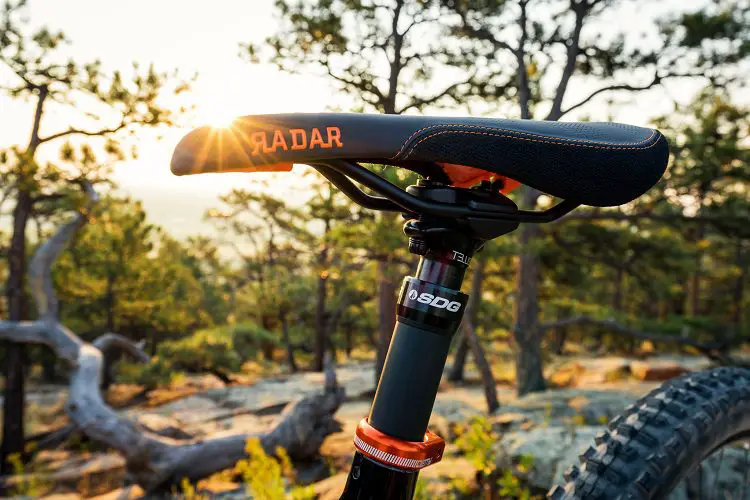
A cross-country bike has a stiff seat post. This is because it focuses on speed instead of comfort. Modern cross-country bikes will be equipped with dropper posts, which allows you a bit more flexibility.
By comparison, trail bikes have dropper posts as a standard feature. In case you don’t know, a dropper post is a bicycle seat post replacement.
It enables you to adjust the saddle height much faster as you don’t have to get off your bike – you can simply do it when you’re on the move.
Wheel Size
A cross-country bike has 29-inch wheels. These make pedaling easier.
Trail bikes will have a greater wheel size range, which is usually around 27.5 and 29 inches. So, there are more options available to help you to find the most comfortable fit.
Terrain
Cross-country bikes are ideal for flatter terrain. They can battle to perform well when it comes to cycling downhill. Trail bikes are suitable for you if you want to ride technical trails and steep ascents.
Handlebars
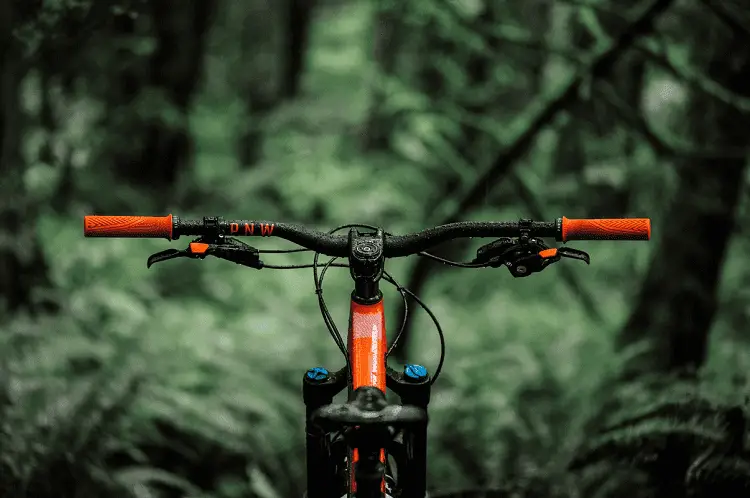
Cross-country mountain bikes have narrow handlebars. These are designed for agility and speed. This handlebar design helps you to steer better around tight corners.
Trail bikes have wider handlebars. These give you greater leverage so you can safely navigate difficult terrain. This prevents you from moving around too much.
Stem
A cross-country bike has a longer stem length – you’re looking at around 90 to 100mm. This lets you move forward on the bike so that you have a better grip of the terrain. It also helps you to move faster.
A trail bike has a shorter stem, which is around 40 to 80mm. This keeps your cycling position further back so you achieve more stability. This is essential when you’re going downhill.
Tires
A cross-country bike has smooth tires. This makes it capable of achieving faster speeds.
By comparison, a trail bike needs to be fitted with heavily-threaded and wide tires to increase stability and grip. This is the bike’s focus as it prioritizes it over speed.
Cross-Country Vs Trail Bike: Which One Is Best For You?
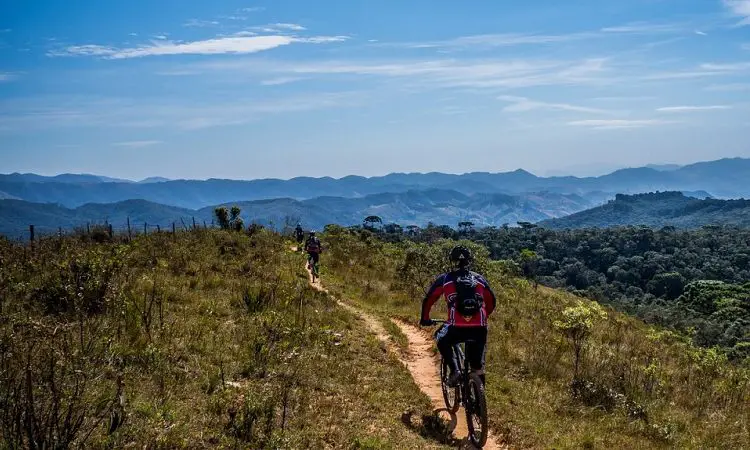
There are clearly many things to consider if you want to purchase a mountain bike. A cross-country bike is best for you if you want to enjoy cross-country racing and/or you want a bike that will perform well in high-speed conditions.
But, if you need to make your way up difficult, steep terrain, a trail bike is the wiser choice. It’s also a good idea if you want to achieve good performance in a wider variety of terrain.
This is a great all-round mountain bike that you can use in many outdoor situations.
Best Cross-Country Bikes
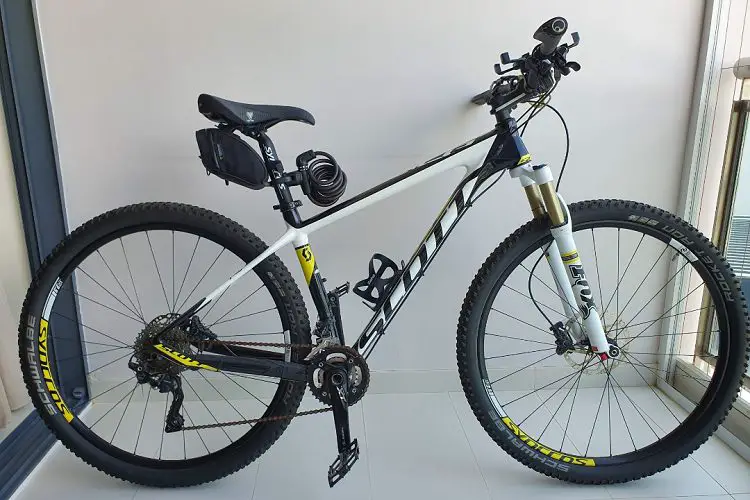
Keen to check out some cross-country bikes? Here are some of the best.
Scott Scale 920
This is more than a cross-country bike – it’s a precision machine that ensures every bit of energy is transformed into speed so you can trek uphill without losing any momentum.
As soon as you push the pedal of this beast, it’ll plunge you into action. Combined with a SRAM Eagle drivetrain and Syncros components, it’s every cross-country racer’s dream.
This bike is also a good all-rounder, but a drawback to bear in mind is that it doesn’t have a remote lockout as compared to some other mountain bikes on the market.
Santa Cruz Tallboy
This XC bike has a lower-link VPP suspension that helps you to navigate a variety of terrain and perform well whether you’re cycling up or down. It’s a lightweight and highly responsive bike that you’ll be able to use in a variety of situations.
Built with 436mm chainstays, this bike remains flexible and nimble no matter what you throw at it. It also has a variety of build options to enable you to customize it to your preferences.
One of the drawbacks of this bike is that it’s been said to be a bit heavier than other cross-country bikes on the market.
Best Trail Bikes
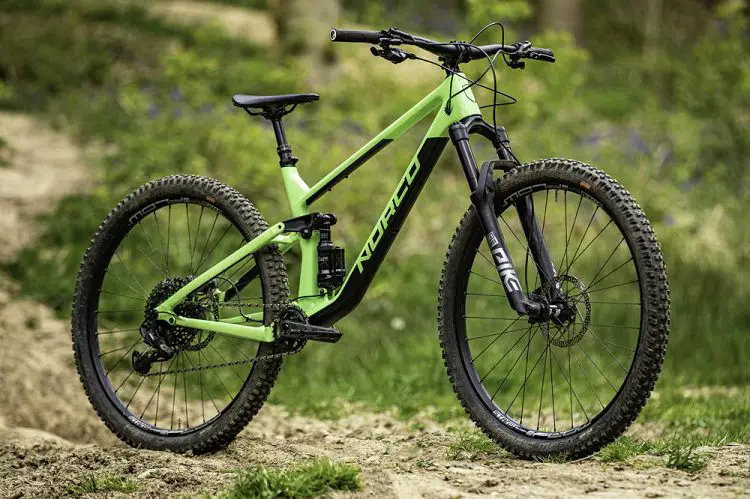
If you think you’d be more interested in riding a trail bike, here are some of the top picks.
Norco Optic C2
This bike has a 29-inch wheel size and comes in a variety of sizes to accommodate you, such as small, medium, and large. It has a balanced geometry that accommodates flat-out riding when required and is well-priced in its category.
It’s equipped with a supportive pedaling platform, enabling you to climb with greater ease. It’s got a carbon frame and is lightweight so that it’s a solid all-rounder.
Some drawbacks, however, are that the Norco Optic C2 could have had better brakes on board and it doesn’t perform as well as it could on rocky trails.
Calibre Triple B
This is a bike that’s been improved from previous models. It contains aluminum tubing to provide it with better geometry to ensure stability at high speeds. This also helps to boost your climbing position. This bike is stable and sturdy so that you can cycle hard.
Thanks to its 140mm fork, this best trail bike comes with a smooth-as-butter suspension. With its softer compound front tire, this trail bike ensures you can lean the bike over on its side when making aggressive sharp turns without falling over.
Something to bear in mind with this trail bike, however, is that it drags a bit when you’re cycling on uphill and flat trails.
Related Questions
What is an enduro bike?
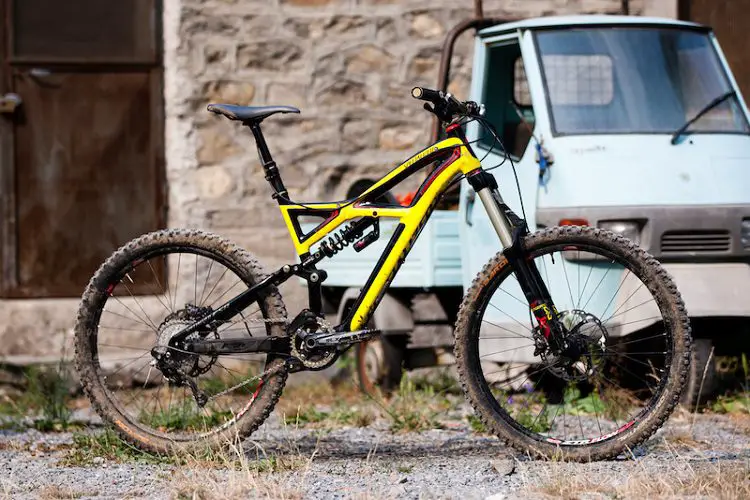
An enduro bike is a long-travel bike that performs well at high speeds and when cycling downhill. It’s designed for these two tasks.
Can you use a mountain bike for your daily commute?
You can use your mountain bike in the city but choose accessories to make your ride much more comfortable, such as swapping the tough tires to semi-slick ones that are more suitable for cycling on tarmac.
Conclusion
If you’re interested in buying a mountain bike, you will have to choose between a cross-country and trail bike. It might not be easy to know which one you should buy at first glance.
That’s why in this article, we’ve featured all you need to know about these different bikes, looking at their respective pros and cons as well as how they compare in a variety of categories.
We’ve also featured some of the best cross-country and trail bikes on the market.
Resources:
Last Updated on July 28, 2023 by Danijel Cakalic

